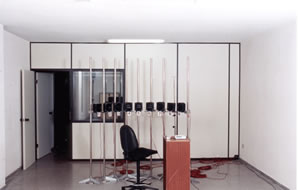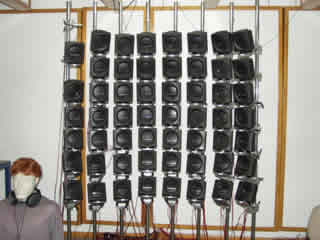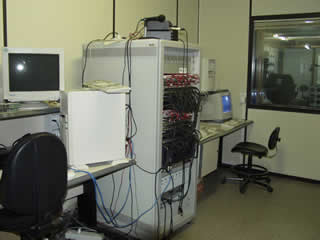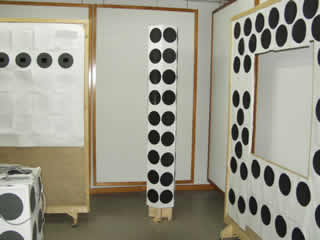Experiments at IAC
Monosource Experiment | Bisource Experiment | Multisource Experiment
During the previous phases of the project a series of experiments was made in the Institute of Astrophysics of the Canary Islands to obtain the necessary knowledge facing approaching the problem to design the system of stereoscopic vision. The experiments evolved gaining complexity and reporting very interesting results for the advance of the investigation and the development of the portable prototype.
During year 96 experiments which we denominated "Monsource Experiment", were carried out in wich we tried to complete the"know how" necessary to obtain the simulations of perception of sounds in the space, as well as to know the sound parameters that produce better locations, to familiarize us with the problematic psychoacoustic technique and that surround to these simulations and finally to confirm the attainment of the same ones with blind people.
These experiments were made with two experimental groups (n=6). A control group of volunteers of both chosen sexes at random, and another one of volunteers with blindness of peripheral origin (without affectation of the central nervous system) and who did not present any type of residual vision. The ages of both groups were included between 18 and 50 years.
The verification in the quality obtained in the generation of externalized sounds through the HRTFs Functions measures was made in both experimental groups. Were not significant differences between both groups. This means that no studied person could physically differentiate the located real sounds in the near space from the generated ones virtually in that space by means of the developed system. Were not either significant differences between both groups in the detection of a sonorous source in azimuth, elevation and distance (z-axis), as much with earpieces (virtual), like with loudspeakers (real). Both experimental groups correctly located to the position of the sonorous source in the space, being significant differences as far as the correct location, as much for real sonorous sources as virtual. These results are in agreement with the bibliographical data available.
During year 97 the methodologic developments were made necessary to make what we called "Bisource Experiment", in which we characterized the psychoacoustic conditioners that are needed to secrete (to identify like separated) two sonorous sources being emitted almost simultaneous sounds in the time, depending on the distance and the azimuthal position and elevation, as well as to study the nature of the sound that more good adapted to the experiments to make. It provided a great amount of information to carry out the future strategies that would be tried in the successive experiments.

Once confirmed the capacity to simulate the sonorous perception like coming from the three-dimensional space and known the necessary psyhoacoustic agreements, the one was made that we denominated "Multisource Experiment", in that was determined which technical and psychological conditioners in the perception of a space are involved, through the three-dimensional location of a multiplicity of independent sonorous sources, using real sources like previous step to the simulation of the same ones.
In general the sounds have a high number of parameters that generate independent perceptions from the psychoacoustic point of view, all which are to be taken advantage of to the maximum to maximize the amount of information which we are able to perceive like three-dimensional information of the space. For the accomplishment of this essential experiment one became necessary to have a series of technical developments, like a system of generation of different sounds with controlable acoustic parameters. The systematization of the design of the sounds that were used in the diverse experiments made developing the specific programs with the intention of botener them of practical form and parametrizada, using MATLAB.
The accomplishment of these experiments was made in a experimentation room of variable and controlable echoicity. In order to generate a great amount of sonorous independent sources, necessary to generate an acoustic scene of the space, it was made necessary to develop an electronics that it made it possible. An audio amplifier of 32 channels, able to produce a set of real sonorous sources from the logout of processing of sounds in real time based on DSP. To the diverse made experiments it was had the possibility of locating up to 40 loudspeakers to distances and controlled directions.


Loudspeakers matrix Control room for the Multisource Experiment.
Here are all the audio devices.
The Multisource Experiment was designed as a key experiment for the final development of the prototype and would have to generate the information necessary to know some critical parameters and to respond to questions like: What type of sound represents better a space surface?, what sonorous density is the optimal one?, what degree of reverberation is necessary?, etc. This experiment, made with such experimental groups already described, demonstrated that in front of a complex presentation of acoustic images (p.e. presence of doors, windows, steps, etc.) the discrimination of the blind people was very superior than the controls, being the differences very significant. The recognition of letters of our alphabet (nonbraille), was extremely difficult for the control group, and however problems for the recognition by the studied blind people did not appear.
The total integration of the system has been made, so that it is possible to be used in a controlled environment (experimentation room with obstacles, objects and controlled forms). It is being proven in voluntary groups of blind people as well as with people with normal vision.
Concrete Results.
The obtained results essentially have been based on two experimental groups:
A.- Blind pleple without visual rest, in its majority, they have been people characterized to have a developed sense of hearing (previous, normal audiometry) and of the direction in well-known surroundings.
B.-Visually enabled volunteers like control group.
The answer has been quantified from the description, as well as in the accomplishment of concrete psychomotrices tasks.. Until the moment the developed system has been tried in a group of 10 blind people and in a similar group of healthy controls. It is necessary to extend the study to a more ampler population and to value his answer.
Although several blind voluntary experience visual evocation of the acoustic stimuli, which improve in a very important form the perception of the surroundings, with the single spacialited perception of sounds is possible to perceive in a clear form the space characteristics of the surrounding objects. In a general way, and considering that the objects to perceive are or vary from precise forms to mono, bi and three-dimensional (which includes horizontal or vertical lines, flat surfaces and concaves or convex curves, isolated or grouped composing figures, like for example, squares, parallel columns, rows, etc., normal simulated surroundings such as rooms, offices, etc.), we could emphasize the following observed aspects:

Experimentation room that reproduces controlled surroundings (column, window, etc.)
- An object in the users's field of perception, from the received sonorous information, can be described, and therefore we concluded that perceived, in significant space aspects as they are its position, its distance and the dimensions in the horizontal and vertical axes, and even in z-axis of depth.
- Two separated objects, everything within the perceptual field caught by the system, can be also perceived in their positions, distances (that can be different, next or more distant), and with their external and internal limits.
- The objects, passed a brief period of exploration, habitually immediate, are perceived in their space disposition in a global way, that is to say, present like a whole in the perceptual field (for example, the presented/displayed sides of a square in the different possible combinations: one or two horizontal lines; one or two verticals, etc., until the total square).
The commented above is translated in which the blind person can recognize the presence of a panel or rectangular surface in its position, to its correct distance and with its dimensions in width and height. The condition of surface is perceived in addition, of space continuity, in a sufficient degree (although we thought that goodable) as to recognize the presence of doors, windows or any other loss of continuity. Two panels as walls forming a corridor are perceived like objects to both sides, with their vertical dimensions and depth, and that in the middle leave a free space through it is possible to walk d and in fact the blind person walk through it. Translated to tasks the most seemed possible to which can be the recognition of common although unknown surroundings, it has been possible that, without leaning for anything in the tact, the blind person could be moved into a very simple experimental room and could graphically extract a picture of it, described global image of the verbal one and, including its general disposition with respect to the departure point, the presence of the walls, its relative disposition, the existence of a hollow as a window in one of them, the position of the door, the existence of a perceived central column in its vertical and horizontal dimensions, which can surround and others obstacles located in the immediate surroundings.
It is necessary to comment that these results have been spontaneous, without is needed to follow a previous learning protocol, which suggests the high potential of the auditory system and the human brain if the opportune stimuli appear to him.

Home | Summary | History | Instituciones | People | Research | Development | Documentation | Patent | Multimedia | News | FAQs